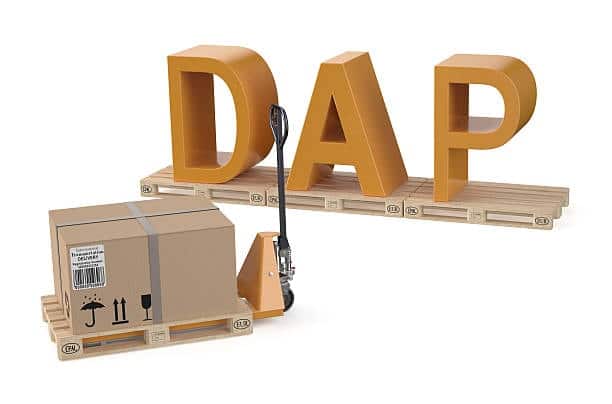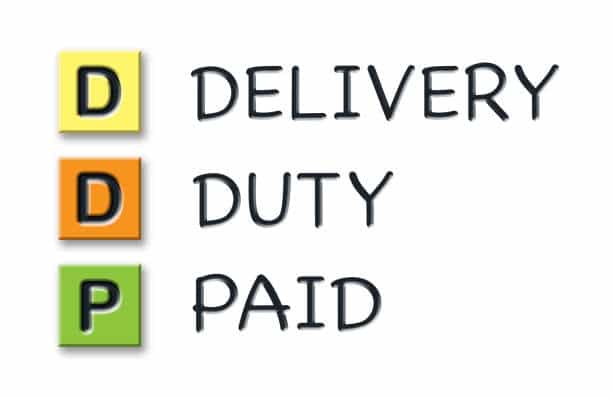International trading presents numerous complexities which are reduced through DAP (Delivered at Place) and similar standardized trade terms. International Chamber of Commerce (ICC) defined DAP delivery terms through the Incoterms® rules to establish precise guidelines about buyer and seller responsibility and cost sharing and risk transfer buyer is responsible. DAP continues to be one of the major options used in global trade since April 2, 2025 because of its flexible terms and balanced structure. This piece examines DAP delivery terms, also known as delivered at place dap, by describing their characteristics and explaining associated duties and positive and negative aspects and real-world implementations.
What Are DAP Delivery Terms?

The international shipping designation DAP stands for Delivered at Place which provides particular arrangements between parties during transportation. The seller must ship goods through transportation to an agreed location between buyer and seller which ensures unloading readiness as per DAP delivery terms all the risks. The buyer is responsible for receiving the goods at the specified delivery location and handles product unloading activities before performing customs clearance functions and paying any customs responsibilities. In 2010 DAP was added to the Incoterms set in place of DDU which stands for Delivered Duty Unpaid while maintaining its position in the 2020 revision.

This delivery term adapts to all transportation methods and includes sea navigation and both air transportation and rail or road logistics and multiple transport modes. The delivery destination under DAP can be either a transportation facility such as a port or airport or it can be a warehouse or the actual premises of the buyer, which is referred to as the final destination, thus providing flexible options for different trade conditions. During DAP the risk transfer point happens when goods reach their destination ready for unloading because this action enables the seller to transfer their responsibilities to the buyer.
Seller’s Responsibilities Under DAP Delivery Terms (delivered at place dap)

The seller is responsible for assuming major responsibilities during DAP delivery terms for delivering goods to their specified destination. These obligations include:
- The seller needs to use proper packaging techniques for transport and supply all required export paperwork including commercial invoices together with packing lists and export licenses.
- The seller must handle every aspect of export clearance operations starting from obtaining customs clearance and paying any necessary duties at the origin country insurance paid.
- The seller fulfills transportation responsibilities by paying expenses from the named place destination through terminal fees and freight expenses and inland delivery costs.
- The seller remains responsible for the loss or damage risks that extend until proper goods delivery to a designated site where unloading commences agreed upon location.
- The seller delivers a transport document that proves the goods arrived at their destination after arrival.

When unloading goods is not specifically included in the contract then sellers are not obligated to perform this task, leaving the buyer responsible for unloading proper clearance. The clear division of work duties becomes possible because of this determination.
Buyer’s Responsibilities Under DAP Delivery Terms

Once the goods arrive at the named place, both the buyer’s responsibilities begin. These include:
- The buyer possesses responsibility for arranging and funding the removal process of goods from transport vehicles at the unloading site.
- The buyer must complete all destination-country import requirements apart from customs clearance and duty payment and tax assessments as well as necessary permits.
- A buyer becomes responsible for all risks of damage or loss that happens to goods when goods become accessible for unloading at the named delivery point.
- Under the sales agreement the buyer must perform payment according to the settlement terms while also offering information to support transport or insurance requirements.
- Buyers must pay for moving goods from transportation facilities to their destination locations when the delivery destination differs from the named place.

The split between cargo ownership and delivery obligations gives control to the buyer during the last stages of delivery in their home country because they bring better expertise to the process.
Advantages of DAP Delivery Terms
The delivery terms DAP provide advantages benefiting buyers and sellers who want to conduct international trade through several attractive benefits.
- The delivery method exists for all kinds of transport systems and offers flexible solutions for different destination points so it accommodates multiple shipping needs.
- The delivery process under DAP delivery terms enables the supplier to take charge of most transportation risks and logistics for protection of the buyer until the goods arrive at the destination.
- Through seller-managed export and shipping responsibilities buyers maintain easier logistical operations for importing and handling domestic tasks.
- The cost structure under this condition delivers predictable breakdowns where the seller pays for transport up to the specified location and afterward the buyer assumes all expenses.
- Inventory Management through delivery-based payments allows buyers to prevent cash flow challenges that occur when payment precedes receipt under different terms.
DAP creates advantages that bring substantial value to buyers who operate in importing or need to optimize their business processes.
Disadvantages of DAP Delivery Terms

Several negative points, including applicable taxes, accompany DAP delivery terms which parties need to assess before implementation.
- The inclusion of transportation expenses and risk costs in the price structure by sellers frequently leads to increased costs for buyers thus turning DAP into a costlier delivery option than FOB (Free on Board).
- The tendency of custom procedures to slow down delivery leads to higher buyer expenses and delayed delivery times.
- Buyers encounter minimal control throughout the shipping process since they must trust their sellers to decide such aspects as carrier selection and routing options.
- When buyers abandon their duty payments to importers the sellers endure significant financial consequences that leads to their merchandise being stuck at the destination.
Trading partners must establish strong communication with built trust because these obstacles reveal the need for it.
Practical Applications of DAP Delivery Terms

Japanese electronics manufacturers use DAP delivery terms to transport 500 laptops to German retailers whose delivery location stands at Berlin warehouse. The seller bears all warehouse delivery tasks from packaging to handling both Japanese export clearance and inbound shipment expenses including both air freight and trucking services between Japan and Berlin. After the shipment reaches Germany the German retailer carries out customs clearance while paying import duties for the received laptops. The buyer assumes all responsibility when goods (unds) reach the warehouse which is prepared for extraction.
The U.S. supplier sends machinery through Port of Vancouver to a Canadian buyer after specifying Vancouver as the named place. Up to the port the seller pays all costs and bears all risks while the buyer handles unloading duties, local taxes, import clearance duties and logistics to their facility. These examples showcase DAP’s versatility across industries and geographies.
Key Differences Between DAP and Similar Incoterms

The understanding of DAP delivery terms can be achieved by differentiating them against other Incoterms such as DDP (Delivered Duty Paid) and DPU (Delivered at Place Unloaded).
- Sales negotiated under DAP cannot assume importer role unlike DDP meaning DAP sellers relinquish import clearance and payment of duties to buyers. DDP shifts considerable obligations to the supplier which creates both financial and operational risks to them.
- DPU contains an unloading requirement for sellers at the place of destination but DAP allows buyers to handle unloading duties. As the only delivery term of its kind DPU requires sellers to unload the shipment at their expense.
Sound practices around the various choices enable both parties to select the delivery term that matches their operational readiness and preferred approach.
Best Practices for Using DAP Delivery Terms
Both parties can attain the highest advantages of DAP by following these steps:
- Both parties should describe the delivery destination precisely to prevent misunderstandings regarding risk transfer.
- The parties can reduce transit risks by reaching an agreement about insurance coverage even though this step is optional.
- A clear stream of information should exist between importers who need precise details about requirements and exporters who should keep the delivery process current both the buyer.
- All terms of the sales contract need detailed documentation using specified Incoterms edition (such as Incoterms® 2020) to avoid any confusion between parties.
The mentioned procedures establish a seamless transaction process when using DAP delivery terms.
Conclusion
The delivery terms known as DAP establish practical guidelines which distribute responsibilities between sellers and buyers in order to boost efficiency for global trade operations. The clarification of seller and buyer duties in DAP becomes clearer because it defines transportation and export responsibilities for the seller and import capabilities for the buyer. The DAP delivery system produces helpful advantages through risk mitigation as well as streamlined logistics but it introduces implementation difficulties like enhanced costs and customs holdups. The knowledge of these operational dynamics enables businesses to use DAP for their particular trade requirements effectively.




